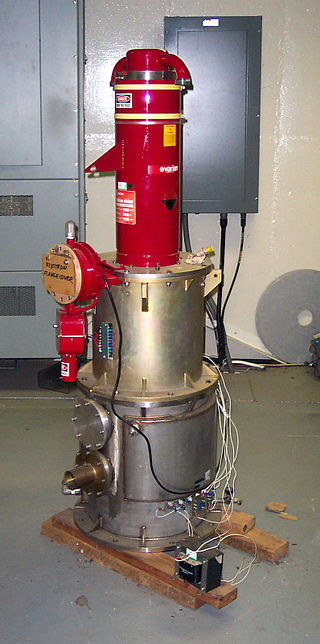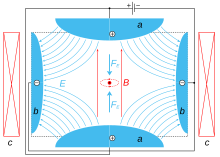
A cyclotron is a type of particle accelerator invented by Ernest O. Lawrence in 1929–1930 at the University of California, Berkeley, and patented in 1932. A cyclotron accelerates charged particles outwards from the center of a flat cylindrical vacuum chamber along a spiral path. The particles are held to a spiral trajectory by a static magnetic field and accelerated by a rapidly varying electric field. Lawrence was awarded the 1939 Nobel Prize in Physics for this invention.

A klystron is a specialized linear-beam vacuum tube, invented in 1937 by American electrical engineers Russell and Sigurd Varian, which is used as an amplifier for high radio frequencies, from UHF up into the microwave range. Low-power klystrons are used as oscillators in terrestrial microwave relay communications links, while high-power klystrons are used as output tubes in UHF television transmitters, satellite communication, radar transmitters, and to generate the drive power for modern particle accelerators.
Mass spectrometry (MS) is an analytical technique that is used to measure the mass-to-charge ratio of ions. The results are presented as a mass spectrum, a plot of intensity as a function of the mass-to-charge ratio. Mass spectrometry is used in many different fields and is applied to pure samples as well as complex mixtures.
Plasma diagnostics are a pool of methods, instruments, and experimental techniques used to measure properties of a plasma, such as plasma components' density, distribution function over energy (temperature), their spatial profiles and dynamics, which enable to derive plasma parameters.
Electron cyclotron resonance (ECR) is a phenomenon observed in plasma physics, condensed matter physics, and accelerator physics. It happens when the frequency of incident radiation coincides with the natural frequency of rotation of electrons in magnetic fields. A free electron in a static and uniform magnetic field will move in a circle due to the Lorentz force. The circular motion may be superimposed with a uniform axial motion, resulting in a helix, or with a uniform motion perpendicular to the field resulting in a cycloid. The angular frequency of this cyclotron motion for a given magnetic field strength B is given by

A synchrocyclotron is a special type of cyclotron, patented by Edwin McMillan in 1952, in which the frequency of the driving RF electric field is varied to compensate for relativistic effects as the particles' velocity begins to approach the speed of light. This is in contrast to the classical cyclotron, where this frequency is constant.

An ion trap is a combination of electric and/or magnetic fields used to capture charged particles — known as ions — often in a system isolated from an external environment. Atomic and molecular ion traps have a number of applications in physics and chemistry such as precision mass spectrometry, improved atomic frequency standards, and quantum computing. In comparison to neutral atom traps, ion traps have deeper trapping potentials that do not depend on the internal electronic structure of a trapped ion. This makes ion traps more suitable for the study of light interactions with single atomic systems. The two most popular types of ion traps are the Penning trap, which forms a potential via a combination of static electric and magnetic fields, and the Paul trap which forms a potential via a combination of static and oscillating electric fields.

Hans Georg Dehmelt was a German and American physicist, who was awarded a Nobel Prize in Physics in 1989, for co-developing the ion trap technique with Wolfgang Paul, for which they shared one-half of the prize. Their technique was used for high precision measurement of the electron magnetic moment.
Fourier-transform ion cyclotron resonance mass spectrometry is a type of mass analyzer (or mass spectrometer) for determining the mass-to-charge ratio (m/z) of ions based on the cyclotron frequency of the ions in a fixed magnetic field. The ions are trapped in a Penning trap (a magnetic field with electric trapping plates), where they are excited (at their resonant cyclotron frequencies) to a larger cyclotron radius by an oscillating electric field orthogonal to the magnetic field. After the excitation field is removed, the ions are rotating at their cyclotron frequency in phase (as a "packet" of ions). These ions induce a charge (detected as an image current) on a pair of electrodes as the packets of ions pass close to them. The resulting signal is called a free induction decay (FID), transient or interferogram that consists of a superposition of sine waves. The useful signal is extracted from this data by performing a Fourier transform to give a mass spectrum.

In experimental physics, a quadrupole ion trap or paul trap is a type of ion trap that uses dynamic electric fields to trap charged particles. They are also called radio frequency (RF) traps or Paul traps in honor of Wolfgang Paul, who invented the device and shared the Nobel Prize in Physics in 1989 for this work. It is used as a component of a mass spectrometer or a trapped ion quantum computer.

In mass spectrometry, Orbitrap is an ion trap mass analyzer consisting of an outer barrel-like electrode and a coaxial inner spindle-like electrode that traps ions in an orbital motion around the spindle. The image current from the trapped ions is detected and converted to a mass spectrum using the Fourier transform of the frequency signal.
Cyclotron resonance describes the interaction of external forces with charged particles experiencing a magnetic field, thus already moving on a circular path. It is named after the cyclotron, a cyclic particle accelerator that utilizes an oscillating electric field tuned to this resonance to add kinetic energy to charged particles.
Quantum electrodynamics (QED), a relativistic quantum field theory of electrodynamics, is among the most stringently tested theories in physics. The most precise and specific tests of QED consist of measurements of the electromagnetic fine-structure constant, α, in various physical systems. Checking the consistency of such measurements tests the theory.
Ion cyclotron resonance is a phenomenon related to the movement of ions in a magnetic field. It is used for accelerating ions in a cyclotron, and for measuring the masses of an ionized analyte in mass spectrometry, particularly with Fourier transform ion cyclotron resonance mass spectrometers. It can also be used to follow the kinetics of chemical reactions in a dilute gas mixture, provided these involve charged species.
Gerald Gabrielse is an American physicist. He is the Board of Trustees Professor of Physics and Director of the Center for Fundamental Physics at Northwestern University, and Emeritus George Vasmer Leverett Professor of Physics at Harvard University. He is primarily known for his experiments trapping and investigating antimatter, measuring the electron g-factor, and measuring the electron electric dipole moment. He has been described as "a leader in super-precise measurements of fundamental particles and the study of anti-matter."

Frans Michel Penning was a Dutch experimental physicist. He received his PhD from the University of Leiden in 1923, and studied low pressure gas discharges at the Philips Laboratory in Eindhoven, developing new electron tubes during World War II. Many detailed observations of gas ionization were done with colleagues, finding notable results for helium and magnetic fields. He made precise measurements of Townsend discharge coefficients and cathode voltage fall. Penning made important contributions to the advancement of high resolution mass spectrometry.

A particle accelerator is a machine that uses electromagnetic fields to propel charged particles to very high speeds and energies, and to contain them in well-defined beams.
In particle physics, the electron mass is the mass of a stationary electron, also known as the invariant mass of the electron. It is one of the fundamental constants of physics. It has a value of about 9.109×10−31 kilograms or about 5.486×10−4 daltons, which has an energy-equivalent of about 8.187×10−14 joules or about 0.511 MeV.
High-precision experiments could reveal small previously unseen differences between the behavior of matter and antimatter. This prospect is appealing to physicists because it may show that nature is not Lorentz symmetric.
A non-neutral plasma is a plasma whose net charge creates an electric field large enough to play an important or even dominant role in the plasma dynamics. The simplest non-neutral plasmas are plasmas consisting of a single charge species. Examples of single species non-neutral plasmas that have been created in laboratory experiments are plasmas consisting entirely of electrons, pure ion plasmas, positron plasmas, and antiproton plasmas.














